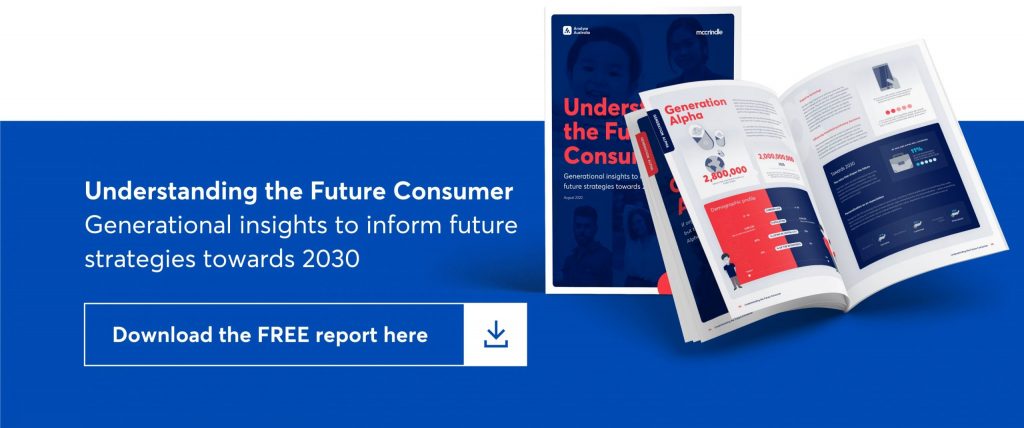By: McCrindle
This global pandemic is bringing about a series of unprecedented events to the Australian economy and our way of living. This will also have a large and likely long-lasting effect on Australia’s demographic landscape.
Australia’s population growth relies on migration. Historically, 60% of Australia’s growth over the past decade has been from net overseas migration (arrivals minus departures). Just the last financial year alone (2018-19), Australia has grown by 232,100 people, through migration. This compares to a growth of just 142,700 through natural increase (births minus deaths).
The ongoing uncertainty over the duration of this public health crisis means that Australia’s border restrictions, reduction of international travel, the severity of COVID-recession, and the migration target in the 2020-21 Federal Budget are all factors that will impact the projected growth of Australia’s population.
Several population forecasts are modelled below based on a range of scenarios flowing from the downturn and recovery of the impacts of COVID-19.
Pre-COVID baseline
Well before COVID-19, the Australia Bureau of Statistics (ABS) projected that Australia will grow to a population size between 29.5 and 31.2 million by June 2031. This is an increase of more than four million from the June 2019 count of 25.4 million. This is based on fertility, mortality and migration assumptions that have, to varying degrees, been affected by COVID-19.
Between June 2020 and June 2031, the mid-range projection series of the ABS forecasts the average annual growth from natural increase to be 166,000. This is based on a constant fertility rate of 1.8 births per woman and a decreasing standardised death rate of 5.4 (2020) to 5.0 (2031) deaths per 1,000 standard population.
Migration follows a different pattern of assumptions since it is largely a factor of targets set by the Federal Government’s migration program.
The Department of Home Affairs’ migration outlook was used until 2021-22. Beyond 2021-22, migration assumptions are based on historical trends as well as the assumption that annual growth by net overseas migration is held constant at 225,000 from 2026-27.
This equates to an average pre-COVID baseline growth of 406,000 people per year between 2020 and 2031.
How COVID-19 changes demographic assumptions
In order to establish a more accurate outlook of Australia’s future population, the aforementioned assumptions will have to be adjusted and account for the health, social, and economic impacts of COVID-19.
The negative health impact of COVID-19 is increasingly well researched and documented. At the time of writing, the rate of deaths associated with COVID-19 is approximately three per cent of total cases globally. For Australia, this rate of death is similar with 897 deaths associated with 27,182 cases of COVID-19. Compared to the expected number of deaths based on historical trends, however, there is inconclusive evidence of excess mortality associated with COVID-19 in Australia – undoubtably a positive outcome of the ongoing public health response and intervention. The assumption in mortality is therefore unchanged, provided that COVID-related deaths remain at a similarly low level.
Fertility assumption is also projected to be unchanged as a result of COVID-19.
While public sentiment towards family formation and birth is likely to shift during economic hardship and an uncertain future, we are not anticipating a reduction in fertility rate in this stage.
As such, assumptions in the domain of natural increase are unchanged compared to pre-COVID baseline.
Net overseas migration (NOM) forecast
Assumptions around net overseas migration, however, must be entirely rebuilt.
As a result of global restrictions of movement and Australia’s own restriction on arrivals and departures, migration has been severely impaired.
With the high level of uncertainty surrounding the duration and severity of the ongoing impact of COVID-19, three series of forecasts have been produced, modelling out a range of scenarios.
Series A – the snap back
COVID-19 unfolded at the beginning of 2020, when on the 30th January, the World Health Organisation declared COVID-19 a public health emergency of international concern. By the 4th April 2020 there were over a million cases of COVID-19 worldwide. Australia’s net overseas migration figure for 2019-20 (year ending June 2020) remained high at 154,000 before falling to -72,000 by 2020-21.
For 2021-22, the snap back scenario accounts for a net overseas migration number of 47,400, approximately 20% of historical levels. Majority of these people will be those returning to Australia, permanent visas in the family and skilled migrants as a result of the Government’s one-off increase in family stream places and priorities for certain skilled stream places. Temporary visas in the higher education sector is also likely to contribute to this, which has historically accounted for more than 20% of Australia’s annual net overseas migration, and a strong economic engine for Australia’s higher education sector.
This scenario assumes that there will be a fast recovery from the impacts of COVID-19, whereby the global perception towards international travel will warm with the availability of an effective vaccine or treatment. This also assumes that economic recovery will take place immediately and Australia’s level of migration will begin snapping back to historical level (average of 237,000 from 2016 to 2019) by 2023-24, with temporary work visa holders, working holiday makers and visitors slowly returning to a normal level.
Under this scenario, Australia’s population forecast for 2031 is 29.6 million, an impairment of 741,000 compared to the pre-COVID ABS baseline.
Series B – delayed recovery
This scenario models a delayed recovery from a slightly more severe impact of COVID-19, with net overseas migration projected to be 23,700 for 2021-22 – approximately 10% of historical level. It assumes that the health, social, and economic impact of COVID-19 will limit the net flow of migrants as well as returning Australians into the country. The major groups and visas will likely to be similar to scenario A, but with longer periods of impairment before a return to pre-COVID level, particularly in the temporary visa categories of visitor, working holiday and temporary skilled work.
In the medium term, however, scenario B does forecast a return of net overseas migration to pre-COVID level by 2026-27.
Under this scenario, Australia’s population forecast for 2031 is 29.3 million, an impairment of one million compared to pre-COVID baseline.
Series C – impaired migration
This scenario forecasts a prolonged impairment to migration, as a result of COVID-19, with the recovery from the initial outbreak of COVID-19 extending to early next decade (2029-30). In this scenario, net overseas migration level is also impaired in the medium to long term.
In this scenario, with a 2022-23 net overseas migration of 20,000, comprising mostly of returning Australians and some permanent visa holders, the health and economic impact of COVID-19 is sustained through the decade. Returning in 2029-30 to a net overseas migration level of 200,000, permanent visa holders are forecasted to decrease by 10% in the long term. Temporary skilled work visas are projected to decrease by 20% as a result of the delayed economic recovery. Higher education visa holders are also projected to decrease by 20% with a contracting global economy. There will also be a net loss of one in three (33%) visitors and working holiday makers long term on account of the poor global economic conditions and a reluctance towards overseas travel.
Depending on the relative public health outcomes between the countries, there could also be a net loss of Australians to New Zealand.
Under this scenario, Australia’s population forecast for 2031 is 28.6 million, an impairment of 1.7 million compared to pre-COVID baseline.
Article supplied with thanks to McCrindle.
About the Author: McCrindle are a team of researchers and communications specialists who discover insights, and tell the story of Australians – what we do, and who we are.
Feature image: Photo by Leio McLaren (@leiomclaren) on Unsplash











